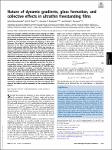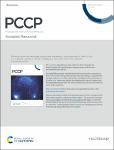Search
Author
- Nguyen K. Ngan (3)
- Alessio Zaccone (2)
- Katsunori Wakabayashi (2)
- Kenneth S. Schweizer (2)
- next >
Subject
- amorphous drugs (1)
- Chemical (1)
- compression effects (1)
- curcumin (1)
- next >
Date issued
Has File(s)
Search Results
Compression effects on alpha and beta relaxation process of amorphous drugs are theoretically investigated by developing the elastically collective nonlinear Langevin equation theory. We describe the structural relaxation as a coupling between local and nonlocal activated process. Meanwhile, the secondary beta process is mainly governed by the nearest-neighbor interactions of a molecule. This assumption implies the beta relaxation acts as a precursor of the alpha relaxation. When external pressure is applied, a small displacement of a molecule is additionally exerted by a pressure-induced mechanical work in the dynamic free energy, which quantifies interactions between a molecule with its nearest neighbors. The local dynamics has more restriction and it induces stronger effects of c... |
Nature of dynamic gradients, glass formation, and collective effects in ultrathin freestanding films Molecular, polymeric, colloidal, and other classes of liquids can exhibit very large, spatially heterogeneous alterations of their dynamics and glass transition temperature when confined to nanoscale domains. Considerable progress has been made in understanding the related problem of near-interface relaxation and diffusion in thick films. However, the origin of “nanoconfinement effects” on the glassy dynamics of thin films, where gradients from different interfaces interact and genuine collective finite size effects may emerge, remains a longstanding open question. Here, we combine molecular dynamics simulations, probing 5 decades of relaxation, and the Elastically Cooperative Nonlinear Langevin Equation (ECNLE) theory, addressing 14 decades in timescale, to establish a microscopic ... |
We theoretically investigate high-pressure effects on the atomic dynamics of metallic glasses. The theory predicts compression-induced rejuvenation and the resulting strain hardening that have been recently observed in metallic glasses. Structural relaxation under pressure is mainly governed by local cage dynamics. The external pressure restricts the dynamical constraints and slows down the atomic mobility. In addition, the compression induces a rejuvenated metastable state (local minimum) at a higher energy in the free-energy landscape. Thus, compressed metallic glasses can rejuvenate and the corresponding relaxation is reversible. This behavior leads to strain hardening in mechanical deformation experiments. Theoretical predictions agree well with experiments. |
Physical properties of the pressure-induced activation volume and dynamic decoupling of ternidazole, glycerol, and probucol by the elastically collective nonlinear Langevin equation theory is theoretically investigated. Based on the predicted temperature dependence of activated relaxation under various compressions, the activation volume is determined to characterize effects of pressure on molecular dynamics of materials. It is found that the decoupling of the structural relaxation time of compressed systems from their bulk uncompressed value is governed by the power-law rule. The decoupling exponent exponentially grows with pressure below 2 GPa. The decoupling exponent and activation volume are intercorrelated and have a connection with the differential activation free energy. Rela... |
A theoretical approach to quantitatively determine the photothermally driven enhancement of molecular mobility of graphene-indomethacin mixtures under infrared laser irradiation is proposed. Graphene plasmons absorb incident electromagnetic energy and dissipate them into heat. The absorbed energy depends on optical properties of graphene plasmons, which are sensitive to structural parameters, and concentration of plasmonic nanostructures. By using theoretical modelling, temperature gradients of the bulk drug with different concentrations of graphene plasmons are calculated. From these, the temperature dependence of structural molecular relaxation and diffusion of indomethacin are determined and how the heating process significantly enhances the drug mobility is found out. |
The temperature dependence of the reversible structural relaxation time and diffusion constant of metallic glasses under pressure is theoretically investigated. The compression not only changes the glassy dynamics, but also generates a metastable state along with a higher-energy state where the system can rejuvenate. The relaxation times for forward and backward transitions in this two-state system are nearly identical and much faster than the relaxation time without accounting for barrier recrossing. At ambient pressure, the expected irreversible relaxation process is recovered, and the numerical results agree well with prior experimental results. An increase in pressure has a minor effect on the relaxation time and diffusion constant that one computes without considering the influ... |
This work develops the elastically collective nonlinear Langevin equation theory to investigate, for the first time, the glassy dynamics in capped metallic glass thin films. Finite-size effects on the spatial gradient of structural relaxation time and glass transition temperature (Tg) are calculated at different temperatures and vitrification criteria. Molecular dynamics is significantly slowed down near rough solid surfaces, and the dynamics at location far from the interfaces is sped up. In thick films, the mobility gradient normalized by the bulk value obeys the double-exponential form since interference effects between two surfaces are weak. Reducing the film thickness induces a strong dynamic coupling between two surfaces and flattens the relaxation gradient. The normalized gra... |
Vacancies are prevalent point defects in crystals, but their thermal responses are elusive. Herein, we formulate a simple theoretical model to shed light on the vacancy evolution during heating. Vibrational excitations are thoroughly investigated via moment recurrence techniques in quantum statistical mechanics. On that basis, we carry out numerical analyses for Ag, Cu, and Ni with the Sutton–Chen many-body potential. Our results reveal that the well-known Arrhenius law is insufficient to describe the proliferation of vacancies. Specifically, anharmonic effects lead to a strong nonlinearity in the Gibbs energy of vacancy formation. Our physical picture is well supported by previous simulations and experiments. |





